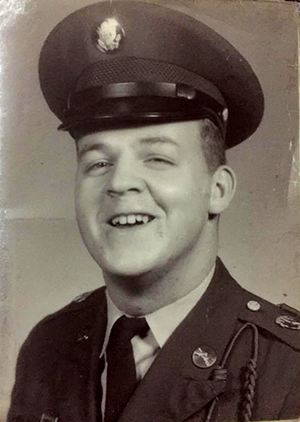

Remember...
Terry Lee McClanahan
1950-1971
"Patriotism is not short, frenzied outbursts of emotion, but the tranquil and steady dedication of a lifetime."
Adlai Stevenson
The town of Chesapeake, West Virginia, sits on the banks of the Kanawha River approximately 15 miles outside of Charleston. Chesapeake got its name from the Chesapeake & Ohio (C&O) Railway that ran through the town since 1873.
Living in a small town would seem like a peaceful existence. However, in the time Terry was growing up, the tense atmosphere left no one unshaken with the Cold War in full force. He had to live through such events as nuke drills, where students would duck under desks to protect themselves from the imaginary nuclear missile, which could, at any moment, become a real one. He also heard about the Korean War, where the valiant efforts of American soldiers were praised. Plenty of West Virginians went to war, leaving the city of Charleston a little emptier, including his home. So, once the Korean War came to an unsteady halt, more trouble was bound to happen.
The Vietnam War was as another example of the power struggle between communism and democracy, just like the Korean War. However, this war had plenty other things to distinguish it, especially because it was the second of its nature. Many Americans were against the war, and even though some politicians saw it as necessary, the people disagreed, especially because of the number of American lives being lost. Vietnam was the first war to sway the public with its intense depiction of the war and guerrilla warfare. The U.S. was at war and needed young men to serve their country. Terry enlisted in the Army as a 67Y10: AH-1 (attack helicopter repairman). He served seven months in Germany prior to his deployment to Vietnam.
Specialist-5 (SP5) Terry McClanahan started his tour of duty in Vietnam on April 11, 1970, and was assigned to F Troop, 8th Cavalry, 23rd Infantry Division (Americal Division). His unit fought in the Campaign of Pleiku, Operation Crazy Horse, Operation Pershing, and many more. (William H. Boudreau, "8th Cavalry Regiment," 8 Cavalry History, 1st Cavalry Association website, accessed 8 February 2023, https://1cda.org/history/history-8cav/.)
On March 3, 1971, the air assault began when elements of the 1st Division were helo-lifted into two firebases (Lolo and Sophia) and Landing Zone (LZ) Liz, all south of Route 9. Eleven helicopters were shot down, and another 44 were damaged as they carried one battalion into Forward Support Base (FSB) Lolo. Three days later, 276 UH-1 helicopters, protected by Cobra gunships and fighter aircraft, lifted the 2nd and 3rd Battalions of the 2nd Regiment from Khe Sanh to Tchepone--the largest helicopter assault of the Vietnam War. Only one helo was downed by anti-aircraft fire as the troops combat assaulted into LZ Hope, four kilometers northeast of Tchepone. For two days the two battalions searched Tchepone and the immediate vicinity, but found little but the bodies of North Vietnamese soldiers killed by air strikes. The PAVN responded by increasing its daily artillery bombardments of the firebases, notably Lolo and Hope. ("Operation Lam Son 719," Fandom [military wiki], accessed 8 February 2023, https://military-history.fandom.com/wiki/Operation_Lam_Son_719.)
SP5 McClanahan's remains were recovered and brought back home to West Virginia. He was buried in Montgomery Memorial Park in London, Kanawha County, West Virginia. At the time of his death, his brother Eugene was a captain in the Army stationed at Ft. Rucker, Alabama, and another brother Jerry was a private first class in the Army stationed at Ft. Hood, Texas.
SP5 McClanahan will always be remembered as he is memorialized at the Vietnam Veterans Memorial in Washington, D.C., on Panel 04W, Line 29, and the West Virginia Veterans Memorial in Charleston, West Virginia. He was posthumously awarded the Bronze Star with Valor and Bronze Star for Merit, the Purple Heart, and the Army Commendation Medal for his honorable efforts.
On January 25, 2022, the West Virginia Legislature introduced House Concurrent Resolution No. 25, wherein it was requested that the Division of Highways rename the temporary Lens Creek Bridge that carried WV 61 over Lens Creek as the "U.S. Army SP5 Terry Lee McClanahan Memorial Bridge." It is fitting that a memorial be established to honor and commemorate the sacrifice SP5 Terry Lee McClanahan made to his state and to his country.
One of his sisters posted this on the Vietnam Veterans Memorial Fund's Wall on Faces in March 2002: "Terry was the one in our family that we looked to for help--he was my brother and my protector when I was little. I miss him every day."
Article prepared by Jeb Morris and MAJ (Ret) Brad McGee, George Washington High School JROTC
February 2023

West Virginia Archives and History welcomes any additional information that can be provided about these veterans, including photographs, family names, letters and other relevant personal history.